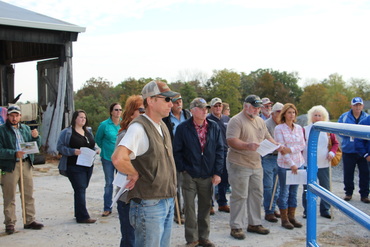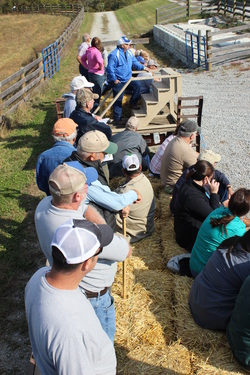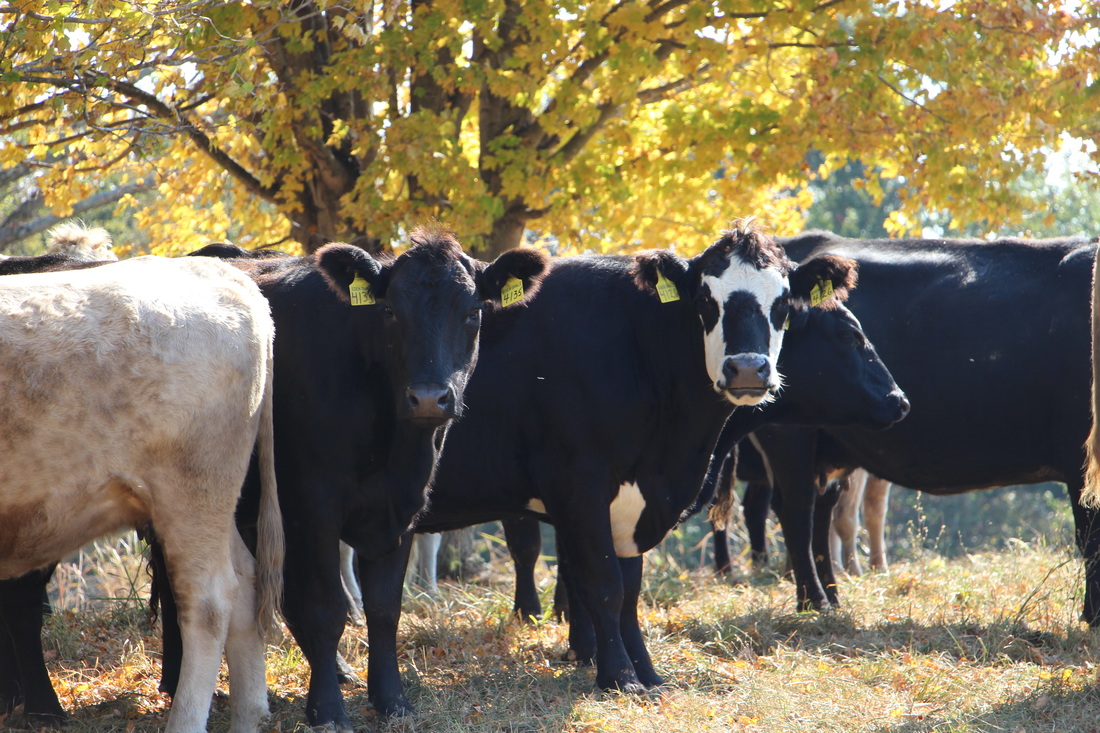|
Eden Shale Farm had their annual open house on Saturday October 15th, 2016. There were about 30 producers in attendance of the event. The day started out with a brief introduction and some important history of Eden Shale Farm given by Dan Miller, Kentucky Beef Network Industry Coordinator. Participants then were asked to go on a tour of the farm.  The first stop was at one of the most recent changes at the farm; what used to be the old dairy barn has now been transformed into a maternity barn. Dr. Steve Higgins from the University of Kentucky accompanied by Dan Miller gave some facts about the new barn. They explained that the floor was redone, bedding was put down and a structure was added to feed hay from. The importance of these renovations is all for the benefit of the cows. The floors made a better ground than the previous concrete to provide more support and less temperature variables for those calving cows. The feeding structure was positioned so multiple fields could access this one structure from different sides, angles and pastures.  Moving along in the tour we also discussed one of the most recent water harvesting techniques Dr. Higgins has designed. This system uses above ground tanks to hold water collected from the roof of the maternity barn. The water is then gravity fed into a tire waterer with shade balls to keep out some of the heat in the summer and assist in reducing freezing in the winter. Next we loaded back onto the wagons and moved to the weaning barn and looked at another water harvesting system using a solar powered pump and cisterns which moved into an above ground water tank which then gravity fed into another tire waterer. As the tour proceeded we made a couple of stops on the way to see the current herd. One of these stops was at the winter feeding pasture where different types of structures have been built to determine which would be the most durable and cost efficient for feeding cattle. This winter will be the first trial of this experiment so stay tuned for those results! Our last stop on the tour was where the current herd is located. We got the chance to look through the herd and Dan talked about the genetic changes they were trying to make in the herd through an Artificial Insemination (AI) protocol. He also explained why Eden Shale Farm’s herd was not a complete registered herd of cattle. Eden Shale’s mission is to be like the average producer, a commercial herd. While trying to be a typical producer they try to publish data farmers can use on their own herds. On the way back to the main field day barn we got the opportunity to hear from Scott Flynn, who is a representative of Dow Agrosciences. Scott talked about different trials of herbicides to control weed growth on the farm, which intrigued farmers on a production standpoint. Once back at the field day barn lunch was served and Dan gave the production report for the farm. This is the first year a production report had been given. Within this report there were statistics from each year Eden Shale has been under the Kentucky Beef Network on basic production numbers and improvements. Reproduction and conception rates, weaning rates and weights were all a part of this report. All in all the Open House was a great day to learn about Eden Shale Farm and for producers to take some knowledge back to their own operations!
If you have been following Eden Shale Farm since KBN took it over in April of 2013 you probably have noticed our continued improvement at the farm. It has been our goal to make cost effective, real world decisions that hopefully keep us representative of the average commercial cattle operation in Kentucky. With that being said, I fully acknowledge that we have a long way to go, and just as the Lowes advertisement states, “Never stop improving”. I want to report on the first three years of operation at Eden Shale Farm and some of the data that has been recorded and the trends that have progressed. Our goal (with insight from the five KBN Managers) is to have roughly 100 head of mama cows calve on the farm each year. Due to the fact that the initial cow herd was purchased out of the stockyards, we have had an average cull rate of 37%. That is an extremely high number by any standards. We continue to retain our own heifers and add young, quality females to the herd. This will continue to allow our cull rates to come down to more normal levels. Our average herd size has been around 80 head, so there is still some room for growth to reach the 100 head goal. Some production numbers that we have been tracking are overall conception rates and weaning weights. Our number of calves sold vs number of cows exposed to breeding has risen from 71% to 94%. Our weaning weights have also increased nearly 100 lbs from 385 lbs to 478 lbs. The biggest factor in the increased weaning weights were the AI sired calves this year, which averaged 34 days older and 37 lbs heavier than the natural service calves. With the help of syncing the cows with AI breeding, we have also shortened our calving window from 105 days to 67 days. The forages at the farm are also better now than they were in 2013. With the help of our industry partners we have been able to renovate several hay fields and pastures. This can be most accurately shown by calculating the number of bales that have been harvested each year on the same number of acres. Hay production has increased 25% from 266 bales in 2013 to 357 bales in 2016 due to the renovations and proper fertilization of the hay fields. The hay field below was renovated to BarOptima Novel Endophyte Fescue. Lastly I want to share a statistic that most farms do not tract, the number of visitors annually. Since 2013 we have had a steady flow of producers and industry professionals visit Eden Shale Farm. We have had a variety of field days, schools, industry trainings, government meetings, and general farm tours. Each year we have experienced a 28% increase in the number of visitors to the farm. In 2016 alone, we hosted 29 groups at Eden Shale Farm for various farm tours/field days and/or trainings. In total we have had over 1,000 people visit from 104 Kentucky counties and 24 states! I will be the first to admit that we still have a lot of room for improvement. But I am proud that in the first three years of production we have trended in the right direction. And as long as you’re moving in a positive direction and learning from your mistakes, you are hopefully going to improve the operation in the long run.
|
Archives
June 2024
Categories
All
Welcome |
CONTACT US |
EMAIL SIGN UP |
|
Eden Shale Farm
245 Eden Shale Rd. Office: (859) 278-0899 Owenton, KY 40359 Fax: (859) 260-2060 © 2021 Kentucky Beef Network, LLC.. All rights reserved.
|
Receive our blog updates
|












 RSS Feed
RSS Feed
